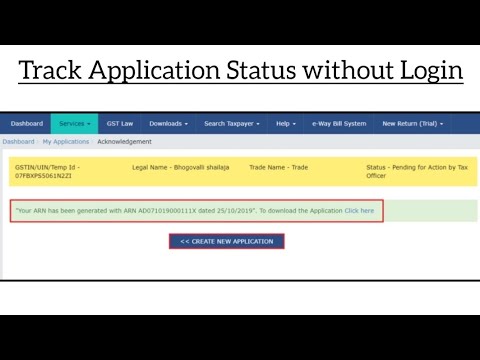Key Takeaways
- ARN is Essential for Tracking: The ARN allows applicants to track the status of their GST registration application through the GST portal.
- Proof of Submission: The ARN serves as proof that the GST registration application has been successfully submitted and received.
- Automated Generation: The ARN is automatically generated upon successful submission of the GST registration application and required documents.
- Format Contains Critical Information: The ARN format includes state code, PAN, and submission date, which helps in uniquely identifying and organizing registration details.
- Required for Future GST Procedures: The ARN is used for subsequent GST-related procedures, such as amendments or queries regarding the original application.
GST registration is a mandatory compliance requirement for businesses that exceed a certain revenue threshold in India. This process integrates businesses into the tax system, allowing them to collect GST from customers and avail input tax credit.
The ARN full form in GST registration known as Application Reference Number, includes a two-digit state code that identifies the state in which the taxpayer is registered, conforming to the Indian state codes established in the Census of 2011. This code is part of the standardized format used to ensure the unique identification of each GST application across India.
What is the GST ARN Number?
The GST ARN Number, or Application Reference Number, is a unique identifier assigned to each GST registration application submitted in India. This number is an alphanumeric code generated automatically when a GST registration form is successfully filed on the GST portal. The ARN is used mainly for tracking the application’s progress while it is being processed by the tax authorities and functions as a receipt for the application submission.

The ARN is crucial because it enables applicants to confirm that their application has been received and is being assessed. Additionally, it enhances correspondence and updates between the applicant and the tax department, ensuring transparency throughout the registration process. Fund agents, mediators, mutual fund advisers, and distributors all utilize this identification.
Once an application is approved, the applicant will receive their Goods and Services Tax Identification Number (GSTIN), but until then, the ARN is the main reference number for the application.
ARN Number Generation Process
The process of generating an Application Reference Number (ARN) during GST registration in India is straightforward and automated. Here’s how it typically works:
Step 1: Submission of GST Application: An individual or business must log into the GST portal and complete the GST registration form. According to the GST laws, this entails providing comprehensive information about the company, including personal and business details, as well as supporting documents.
Step 2: Document Upload: Along with the application, relevant documents must be uploaded. These typically include proof of business registration, the PAN (Permanent Account Number) of the business or individual, photographs of the proprietors or partners, proof of business address, and bank account details, among others.
Step 3: Validation of Information: Once the application is submitted and documents are uploaded, the information is automatically checked for completeness and correctness. This validation includes checks on the format and authenticity of uploaded documents and details provided in the application.
Step 4: ARN Generation: If the application is correctly filled out and all required documents are in order, the system will generate an ARN immediately after submission. This ARN number status is displayed on the screen and also sent to the registered email address and mobile number of the applicant.
Step 5: Confirmation Receipt: The applicant receives a confirmation receipt along with the ARN, which serves as proof of submission of the GST registration application. This receipt can be printed or saved for future reference.
Why is an ARN Number Considered So Important?
The Application Reference Number (ARN) is considered a crucial element in the GST registration process for several reasons:
- Tracking Application Status: The ARN allows applicants to track the status of their GST registration application online through the GST portal. This feature is essential as it provides transparency and real-time updates on the processing stage of the application, helping applicants understand whether their application is under review, approved, or requires additional information.
- Proof of Submission: The ARN serves as proof that the GST registration application has been successfully submitted. This is particularly important in scenarios where documentation or confirmation from the tax authorities is required to demonstrate that the registration process is underway.
- Error Resolution: If there are any issues or errors in the application, the ARN is used to reference the specific application when communicating with GST helpdesk or support services. This facilitates quicker resolution of issues as the ARN directly links to the specific details and status of the applicant’s submission.
- Subsequent Procedures: After submitting the initial registration application, if an applicant needs to make amendments or provide additional information, the ARN is used to link these subsequent actions to the original application. This helps maintain continuity and accuracy in the applicant’s records with the GST authorities.
- Mandatory for Future References: The ARN is required not just at the time of initial registration but also for other procedures under the GST framework, such as amendments, updates, or deregistration processes. It acts as a reference point for all related GST activities.
Compulsory Documents Required for Application Reference Number (ARN)

To obtain an Application Reference Number (ARN) as part of the GST registration process in India, applicants must submit a set of compulsory documents. These documents are essential for verifying the identity and legality of the business or individual applying for GST registration.
Here’s a list of the typical documents required:
- PAN Card: The Permanent Account Number (PAN) card of the business or the individual applicant is mandatory for GST registration.
- Proof of Business Registration: Depending on the type of business, this could include a certificate of incorporation (for companies), partnership deed (for partnerships), registration certificate of the firm, etc.
- Identity Proof of Promoters/Directors: Documents like PAN cards, Aadhaar cards, or passports of the promoters or directors of the business.
- Address Proof of Promoters/Directors: Documents such as recent utility bills, passports, Aadhaar cards, or voter IDs that provide proof of the residential addresses of the promoters or directors.
- Proof of Business Address: This can include documents like a recent utility bill, municipal khata copy, property tax receipt, lease or rent agreement, consent letter, etc.
- Bank Account Details: A copy of a canceled cheque or bank statement, passbook/bank account statement that bears the account holder’s name, MICR code, IFSC, and branch details.
- Digital Signature: A valid digital signature of the authorized signatory is required to submit the GSTN Portal application online.
- Letter of Authorization/Board Resolution for Authorized Signatory: This is necessary if the person handling GST matters is different from the business owner or company directors.
- Photographs: Passport-sized photographs of the owners, partners, or directors of the business are also required.
These documents must be uploaded to the GST portal as part of the application process. After the documents and application are verified, the ARN is generated, which effectively serves as an acknowledgment and tracking number for the registration process.
How to Check Application Status by ARN Number?

To check the GST registration status or GST ARN Status using the Application Reference Number (ARN) in India, you can follow these steps:
- Access the GST Portal
Open a web browser and go to the official GST Portal at www.gst.gov.in. - Login to Your Account
On the homepage of the GST portal, click on the ‘Login’ button located at the top right corner of the page.
Enter your username and password to log in to your GST account. - Navigate to the Tracking Section
After logging in, navigate to the ‘Services’ menu on the dashboard.
Under ‘Services’, find and click on ‘Registration’.
Select ‘Track Application Status’ from the options available under Registration. - Enter Your ARN
On the ‘Track Application Status’ page, you will see a field to enter your ARN (Application Reference Number).
Type your ARN into the provided field. - Submit and View Status
Click on the ‘Search’ button after entering your ARN.
The status of your application will be displayed on the screen. This can include statuses such as ‘Draft’, ‘Pending for Verification’, ‘Approved’, ‘Rejected’, or ‘Pending for Clarification’, depending on where the application is in the processing pipeline. - Understanding the Status
If the application is approved, you will see the GSTIN (GST Identification Number) and the effective date of registration.
If additional clarifications are needed or errors need to be corrected, details and instructions will be provided on how to proceed.
ARN Format
The Application Reference Number (ARN) in the context of GST (Goods and Services Tax) registration in India follows a specific structured format that helps in uniquely identifying and tracking each application.
The format of the ARN is: AA: State Code; PAN: YYYYMM; ZZZZZ: Check sum digit
Each component of the ARN format serves a specific purpose:
- AA: This is a fixed prefix for all ARNs issued under the GST system.
- State Code: This is a two-digit code that represents the state where the GST registration is being applied for. Each state in India has a unique code based on the Indian Census 2011.
- PAN: This is the ten-character Permanent Account Number of the taxpayer or the entity that is applying for GST registration.
- YYYYMM: This represents the year and month when the application for GST registration was filed. For example, if the application was filed in March 2024, this part of the ARN would be 202403.
- ZZZZZ: This is a unique sequential number (a serial number) that differentiates all ARNs generated within the same month for the same PAN in the same state.
- Check sum digit: This ensures the accuracy of the ARN.
This structured format allows the GST system to efficiently manage, track, and process applications. It ensures that each ARN is unique and can be used to retrieve the specific details and status of any GST registration application across India.
What are the different types of ARN status?

When you submit a GST registration application and receive an Application Reference Number (ARN), you can track the status of your application through the GST portal. Each types of status provides insight into the current stage of your application’s review process.
Here are the different types of GST ARN application statuses you might encounter:
- Draft: This status indicates that the application has been partially completed and saved as a draft. The applicant has not yet submitted the application for processing.
- Pending for Verification: This status shows that the application has been successfully submitted and is currently awaiting initial scrutiny by the GST officer.
- Migrated: This status applies to normal taxpayers who were previously registered under the old tax regime (like VAT or Service Tax) and have migrated to GST. The status remains “migrated” until the individual taxpayer submits all necessary information and completes the formalities for the new GST regime.
- Provisional: This is an interim status provided to existing taxpayers migrating to GST, allowing them to continue business operations until their application is fully processed.
- Cancelled: This status indicates that the registration application has been cancelled. This can happen either because the applicant has withdrawn the application or because the GST authorities have rejected it due to non-compliance or discrepancies.
- Rejected: If the GST authorities find any discrepancies or if the applicant fails to respond to queries or notices, the application may be rejected. Detailed reasons for rejection are typically provided.
- Approved: This status denotes that the GST authorities have approved the application. The applicant will receive their GST Identification Number (GSTIN), which is necessary for all future GST-related transactions.
- Pending for Clarification: This status appears when the GST officer has requested additional information or clarification regarding the application. The applicant needs to respond to these queries to proceed with the application process.
- Clarification Filed—Pending for Order: After the applicant provides the necessary clarifications requested by the GST officer, this status reflects that the clarifications are under review, and a decision is pending.
- Clarification Not Filed—Pending for Order: This status is shown if the applicant has not provided the requested clarifications within the specified time frame. The application is pending a decision based on the information already submitted.
Conclusion
The Application Reference Number (ARN) is a pivotal part of the GST registration process in India. It acts as a special identification code for each application for GST registration that is filed, giving applicants a way to monitor the progress of their registration via the GST site.
The Application Reference Number (ARN) verifies that the application was submitted, helps with error correction, and connects further GST-related processes to the original application. This allows companies and individuals to easily integrate into the GST system by guaranteeing efficiency and transparency in the administration of GST registrations.
If you’re having trouble keeping up with your GST bills, consider trying Pice. This business payment app allows you to schedule your payments efficiently, helping you manage your finances better and avoid late fees. Download Pice today and simplify your GST payments.
FAQs
What is an ARN in GST?
The ARN, or Application Reference Number, is a unique number generated when a GST registration application is submitted. It serves as proof of the application submission and is used to track the status of the application through the GST portal.
How can I check my GST application status using the ARN?
To check your GST application status using the ARN, log into the GST portal, navigate to the ‘Services’ menu, select ‘Registration’, then ‘Track Application Status’, and enter your ARN. The current status of your application will be displayed.
What should I do if my GST application is rejected?
If your GST application is rejected, review the reasons provided for rejection on the GST portal, correct any errors or provide the required information, and resubmit your application. A new ARN may be generated upon resubmission.
How long does it take to get the GSTIN after the ARN is generated?
The time to receive the GSTIN after the ARN is generated can vary, but typically takes about 7 to 10 days if all documents are in order and no discrepancies are found during the verification process.
Can I use the ARN for any purpose other than tracking the GST application status?
The primary purpose of the ARN is to track the status of your GST registration application. However, it also serves as a reference number for any communications with the GST authorities regarding your application.








